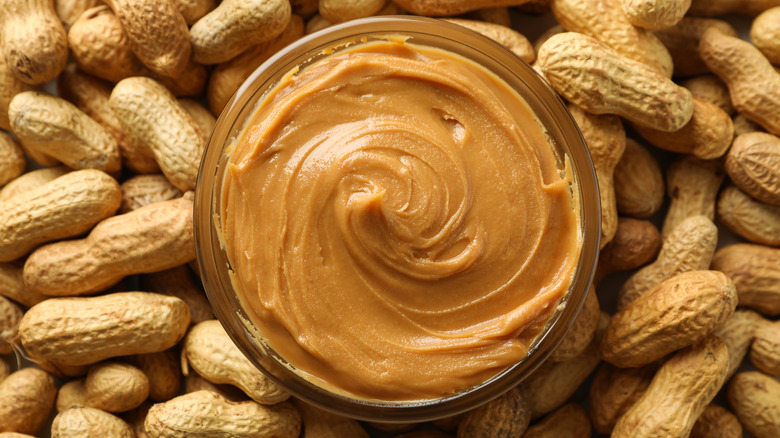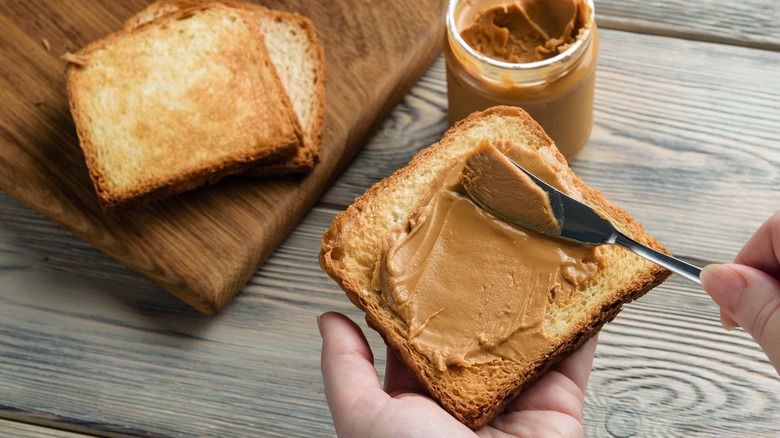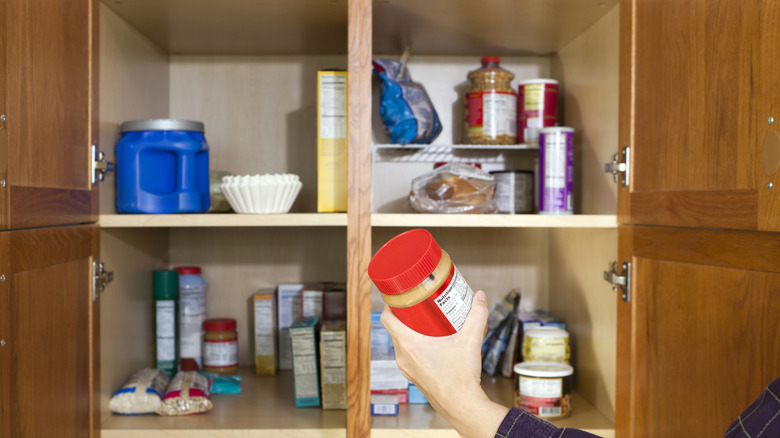Peanut Butter Does Indeed Go Bad. Here's How To Tell
With its creamy texture and bold flavor, peanut butter is one of the most beloved treats out there. As a bonus, it has a long shelf life and doesn't require refrigeration. You can keep it in your pantry or take it on trips and use it over several weeks. An unopened jar will last six to nine months, per the USDA. But once opened, it should be consumed within two to three months.
This delicious treat lasts so long due to its low moisture content. Additionally, it may contain hydrogenated oils, preservatives, and other ingredients that contribute to its long shelf-life. But peanuts (and their derivatives) are also high in fat and can go rancid when stored in warm conditions or for extended periods, according to 2019 evidence published in Food Science and Nutrition. There's also a risk of mold or bacterial growth, which can lead to foodborne illnesses. For example, in 2022, the Washington State Department of Health warned about a salmonella outbreak linked to peanut butter.
Generally, it's safe to eat rancid peanut butter if you can stand the taste. "Some people actually eat rancid food without knowing it, depending upon their individual taste buds," Maribeth Cousin, a food microbiology professor at Purdue University, said to Live Science in 2012. However, rancidity differs from spoilage, so make sure you know when to throw away that jar of peanut butter in your kitchen.
How to tell if you should throw away your peanut butter
Peanut butter is one of those groceries with surprisingly long shelf lives, but it can still go bad. First, you may notice changes in its smell and taste, such as a rancid flavor. Over time, its color may become darker — and you might also see green, white, or fuzzy patches, which are signs of mold. Note that it's normal to see the oils in peanut butter floating on top. Simply mix them in with a teaspoon or turn the jar upside-down.
Do a sniff test to see if your peanut butter is still edible. Does it have a chemical smell or any off-odors? In this case, it may no longer be good. A dry consistency or slimy texture can be a sign of spoilage, too. Less commonly, peanut butter may become contaminated with ants or other insects. If that's the case, discard the jar immediately.
Beware that peanut butter can go bad even when unopened. This may happen if you store it for too long or in extreme heat. For instance, keeping a jar of peanut butter next to the stove can result in spoilage and rancidity.
How to store peanut butter for a longer shelf life
Like other pantry staples, peanut butter should be stored in a dry, cool place, such as a kitchen cabinet. If it contains hydrogenated oils and the jar is sealed, you may refrigerate it for up to 12 months, notes FoodSafety.gov. Once opened, it can be stored in the fridge for three to four months. The same guidelines apply to natural peanut butter. Again, it's perfectly fine to store your peanut butter in the pantry, but refrigeration may increase its shelf life and prevent rancidity.
Another option is to freeze it in ice cube trays or airtight containers. Alternatively, you could make peanut butter cookies or ice cream and freeze them for later. Thaw them in the refrigerator, and enjoy.
As a rule of thumb, use a clean spoon or knife to serve peanut butter. This helps preserve its flavor while reducing the risk of cross-contamination. Also, remember that you can always make peanut butter at home, so there's no need to buy a bunch of jars for later use. Simply mix 1 or 2 cups of roasted peanuts, a teaspoon of vegetable oil, and a pinch of salt in a high-speed blender, and then transfer the nut butter to a glass jar. Add raw honey, stevia, cinnamon, or dark chocolate chips for extra flavor.


